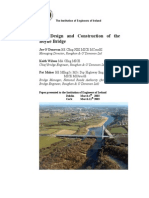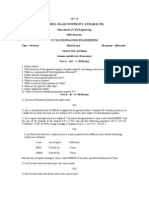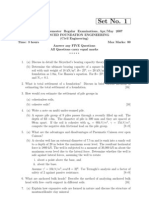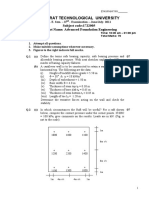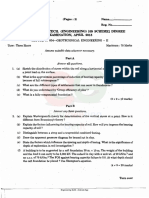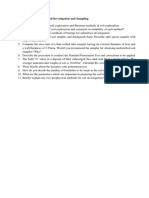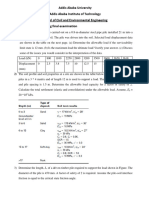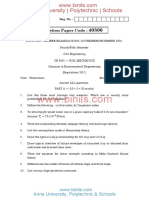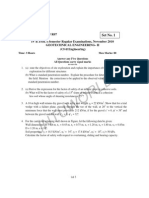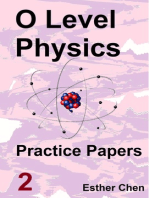2020 10 19SupplementaryCE364CE364 F Ktu Qbank
2020 10 19SupplementaryCE364CE364 F Ktu Qbank
Uploaded by
Roshiya FathimaCopyright:
Available Formats
2020 10 19SupplementaryCE364CE364 F Ktu Qbank
2020 10 19SupplementaryCE364CE364 F Ktu Qbank
Uploaded by
Roshiya FathimaCopyright
Available Formats
Share this document
Did you find this document useful?
Is this content inappropriate?
Copyright:
Available Formats
2020 10 19SupplementaryCE364CE364 F Ktu Qbank
2020 10 19SupplementaryCE364CE364 F Ktu Qbank
Uploaded by
Roshiya FathimaCopyright:
Available Formats
Reg No.
:_______________ 03000CE364052001Name:__________________________
APJ ABDUL KALAM TECHNOLOGICAL UNIVERSITY
Sixth semester B.Tech degree examinations (S), September 2020
Course Code: CE364
Course Name: ADVANCED FOUNDATION ENGINEERING
Max. Marks: 100 Duration: 3 Hours
PART A
Answer any two full questions, each carries 15 marks. Marks
1 a) Briefly describe the general requirements of foundations. (5)
b) A rectangular footing of dimensions 2.5 m X 3 m in plan is founded at a depth of 1.5 m (10)
below the ground level. The load on the footing acts at an angle of 15o to the vertical and
is eccentric in the direction of the width by 10 cm. The saturated unit weight of soil is 18
kN/m3. C’=15 kN/m2, Φ’=30o. Water table is at a depth of 2m below the ground surface.
Use IS 6403-1981 recommendations to calculate the net ultimate bearing capacity. For
Φ’=30o, Nc=30.14, Nq= 18.4, Nγ=22.4
2 a) Briefly describe the effect of size on the settlement of footings on homogeneous sand (5)
deposits.
b) A square footing of size 6m X 6 m is founded at a depth 2m below ground surface in (10)
loose sand with a net loading intensity of 100 kN/m2. The water table is at the base of the
foundation. Above the water table, γ= 16 kN/m3 and submerged unit weight = 9 kN/m3.
Compute the elastic settlement using Steinbrenner’s curve. Take µ= 0.3, depth of
compressible layer is 12 m and Es=7000 kN/m2
Page 1 of 3
For More Visit : KtuQbank.com | Fair Use Policy
03000CE364052001
3 a) Compute the net safe bearing pressure of a circular footing 3 m diameter founded in a (10)
deposit of fine sand at a depth of 1.5m below ground surface. Water table occurs a depth
of 3 m below ground level. The unit weight above water table is 18 kN/m3. The average
N value for a depth of 6 m below the base of the footing is 18. Use Teng’s correlation.
The allowable settlement is 25 mm.
b) Briefly discuss the methods to reduce heave during excavations. (5)
PART B
Answer any two full questions, each carries 15 marks.
4 a) A circular concrete pile of diameter 450 mm is installed in a clay stratum having (7)
undrained shear strength of 100 kPa. Determine the length of the pile needed if the pile
has to carry a load of 420 kN with a factor of safety of 2.5 against shear failure. Take
adhesion factor of 0.6.
b) Discuss the different types of pile load tests. (8)
5 a) A concrete pile, 9m long, was driven by a single acting hammer with rated energy 40 kJ. (6)
The total settlement as recorded for the last 10 blows was 2.5 mm/ blow. Using
Engineering News Record formula, calculate the pile capacity.
b) A concrete square pile is 16 m long and 410 mm X 410 mm in cross-section. The pile is (9)
3
fully embedded in sand having unit weight of 17 kN/m and angle of internal friction
30o. Determine the ultimate load carrying capacity of the pile. Assume Nq= 90; K is one
half of coefficient of passive earth pressure and δ=0.75Φ
Page 2 of 3
For More Visit : KtuQbank.com | Fair Use Policy
03000CE364052001
6 a) The following data was obtained in a vertical pile load test on a 400 mm diameter pile (7)
Load (kN) 50 100 200 300 400 500 600
Settlement(mm) 2.5 4 10 17 28 41 63
Plot the load-settlement curve and determine the allowable load as per IS code.
b) A 20 m deep bored pile has a shaft of 1 m diameter and enlarged base of 2 m diameter in (8)
the lower 1 m depth. The undrained cohesion of soil varies from 100 kN/m2 at top to 250
kN/m2 at the base. Determine the safe load (F.S = 2.5,α =0.45)
PART C
Answer any two full questions, each carries 20 marks.
7 a) List the forces acting on well foundation (4)
b) A group of nine piles arranged in a square pattern is to be proportioned in a deposit of (12)
soft clay to carry an incoming load of 550 kN. Calculate the settlement of the pile group
by equivalent raft approach if the piles are square with side 300 mm and have a centre to
centre spacing of 500 mm. The thickness of the stratum is 8 m and the piles are
embedded to a length of 5 m in the clay. The properties of the clay are given as: γsat = 19
kN/m3, wL= 45% and e= 1.5. Ground water table is at the ground surface.
c) Explain the concept of negative skin friction (4)
8 a) A group of 16 piles of 45cm diameter is arranged with a center to center spacing of 1.0m. (10)
The piles are 8m long and are embedded in soft clay with cohesion 30kN/m2. Adhesion
factor is 0.54. Determine the ultimate load capacity of pile group.
b) Explain the components of well foundations and its functions with a neat sketch. What (10)
are the different shapes of well foundations?
9 a) A single tube circular well foundation of 3.5 m diameter is installed to a depth of 7m (5)
below the scour level in granular soil. The corrected standard penetration value (N value)
in the bearing stratum is 60. Estimate the allowable bearing pressure of the well
foundation.
b) Explain Terzaghi’s analysis of lateral stability of well foundation. (7)
c) Describe the methods to correct tilts and shifts during well sinking. (8)
****
Page 3 of 3
For More Visit : KtuQbank.com | Fair Use Policy
You might also like
- Standard Data Book For Analysis of Rates - 1Document577 pagesStandard Data Book For Analysis of Rates - 1Pruthvi Teja87% (45)
- Boyne BridgeDocument43 pagesBoyne Bridgeianfld100% (1)
- Preparation of Inspection & Test Plans For Civil & Steelworks, Rev.0 Foster Wheeler Energy LTD Work Practice Construction OperationsDocument5 pagesPreparation of Inspection & Test Plans For Civil & Steelworks, Rev.0 Foster Wheeler Energy LTD Work Practice Construction Operationssateeshsingh100% (2)
- Ce364 CDocument4 pagesCe364 Cu19n6735No ratings yet
- Foundation Engg Modal Question BDocument3 pagesFoundation Engg Modal Question Bmahil1234No ratings yet
- Cet305 Geotechnical Engineering-Ii, December 2023Document3 pagesCet305 Geotechnical Engineering-Ii, December 2023basiljoy787No ratings yet
- CE305-QPDocument3 pagesCE305-QPNusfa KaruvattilNo ratings yet
- Cet305 Geotechnical Engineering-Ii, December 2021Document3 pagesCet305 Geotechnical Engineering-Ii, December 2021basiljoy787No ratings yet
- Important Questions For All UnitDocument4 pagesImportant Questions For All UnitSheik Althaf Hussain ANo ratings yet
- Nov2017 Re-Exam FE 100%Document2 pagesNov2017 Re-Exam FE 100%kirtiNo ratings yet
- Advanced Foundation Engineering Rr420101Document8 pagesAdvanced Foundation Engineering Rr420101Andronico BintiNo ratings yet
- Afe QuesDocument8 pagesAfe Questkumar111No ratings yet
- Assignment # 4Document2 pagesAssignment # 4Anonymous Vx9KTkM8nNo ratings yet
- Gujarat Technological University: InstructionsDocument3 pagesGujarat Technological University: InstructionsHIMANSHUNo ratings yet
- FAD KTU Question Paper - May 2016Document3 pagesFAD KTU Question Paper - May 2016Jimmy ThomasNo ratings yet
- CE09 604 Geotechnical Engineering II APR 2015Document2 pagesCE09 604 Geotechnical Engineering II APR 2015Akhil MuralidharanNo ratings yet
- University of ExaminationDocument4 pagesUniversity of Examinationforplayinggame120No ratings yet
- FE Imp QuestionsDocument8 pagesFE Imp QuestionsYeswanth PaluriNo ratings yet
- First Semester M.E. (Civil) Degree Examination, March 2013 Geotechnical Engineering 2K8Gt 105: Design of Shallow FoundationsDocument5 pagesFirst Semester M.E. (Civil) Degree Examination, March 2013 Geotechnical Engineering 2K8Gt 105: Design of Shallow FoundationsBerryl Khalif MaizarNo ratings yet
- Question Paper - GIAN - 19 - ModifiedDocument4 pagesQuestion Paper - GIAN - 19 - Modifiedsayan mukherjeeNo ratings yet
- (10 Marks) : Faculty of EngineeringDocument4 pages(10 Marks) : Faculty of EngineeringChamin SubhawickramaNo ratings yet
- r7410101 Geotechnical Engineering IIDocument4 pagesr7410101 Geotechnical Engineering IISiva SankarNo ratings yet
- Ce 326 Gte-Ii (R12) Set - 1Document2 pagesCe 326 Gte-Ii (R12) Set - 1gollapalli sushmithaNo ratings yet
- Project On GED IIDocument4 pagesProject On GED IIakhjazrNo ratings yet
- Assignment 3 (Due Date 14 Dec 2021)Document4 pagesAssignment 3 (Due Date 14 Dec 2021)Ho JamesNo ratings yet
- CE - 303 - GE - End Sem-1Document3 pagesCE - 303 - GE - End Sem-1Anudeep KumarNo ratings yet
- CE407 - Updated Midsem SolutionsDocument31 pagesCE407 - Updated Midsem SolutionsManan GoyalNo ratings yet
- Enroll. No. Rajarambapu Institute of Technology, Rajaramnagar QP CodeDocument2 pagesEnroll. No. Rajarambapu Institute of Technology, Rajaramnagar QP CodekirtiNo ratings yet
- TR 334 Tutorial-1Document5 pagesTR 334 Tutorial-1Adaminovic MrishoNo ratings yet
- CV3013 - Tutorials 1 To 3 (2015) PDFDocument3 pagesCV3013 - Tutorials 1 To 3 (2015) PDFlevanviet0410100% (1)
- ProblemsDocument4 pagesProblemsbalaNo ratings yet
- Ce 441 Foundation Engineering - 2021 Fall Homework 1Document2 pagesCe 441 Foundation Engineering - 2021 Fall Homework 1Yusuf DuranNo ratings yet
- CT II QP Sep'11Document4 pagesCT II QP Sep'11Rajha RajeswaranNo ratings yet
- University of Mauritius Faculty of EngineeringDocument6 pagesUniversity of Mauritius Faculty of EngineeringAvinaash VeeramahNo ratings yet
- 15CV53Document2 pages15CV53Vijay KulkarniNo ratings yet
- Model Question Paper (CBCS Scheme)Document2 pagesModel Question Paper (CBCS Scheme)Veeresh PattarNo ratings yet
- Sem 8 AssignmentsDocument22 pagesSem 8 AssignmentsChirag MistryNo ratings yet
- M. H. S. S. College of Engineering Department of Civil EngineeringDocument3 pagesM. H. S. S. College of Engineering Department of Civil Engineeringjay shankar prabhatNo ratings yet
- Home Work - Cem605Document5 pagesHome Work - Cem605neelNo ratings yet
- Foundation EngineeringDocument12 pagesFoundation EngineeringSindhu Chowhan100% (1)
- Geotech Engg QuestionsDocument2 pagesGeotech Engg QuestionsYashasviNo ratings yet
- Gujarat Technological University: InstructionsDocument2 pagesGujarat Technological University: InstructionsHIMANSHUNo ratings yet
- Advanced Soil Mechanics s1 M.tech Ce Ktu 2016 Feb.Document3 pagesAdvanced Soil Mechanics s1 M.tech Ce Ktu 2016 Feb.Nirmal PanditNo ratings yet
- Show All The Necessary Steps To Solve The Following ProblemsDocument2 pagesShow All The Necessary Steps To Solve The Following ProblemsMistireselassieNo ratings yet
- CE8491 Soil MechanicsDocument4 pagesCE8491 Soil MechanicsM.S ROOBININo ratings yet
- WWW - Manaresults.Co - In: Geotechnical Engineering - IiDocument1 pageWWW - Manaresults.Co - In: Geotechnical Engineering - IimaheshNo ratings yet
- AssignmentDocument3 pagesAssignmentsajjadsiyal144100% (1)
- Fe Set ADocument2 pagesFe Set ArishinathnehruNo ratings yet
- 463III B.Tech II Semester Examinations, APRIL 2011 GEOTECHNICAL ENGINEERING-IDocument8 pages463III B.Tech II Semester Examinations, APRIL 2011 GEOTECHNICAL ENGINEERING-Isujan_duttaNo ratings yet
- CE8591 Foundation EngineeringDocument2 pagesCE8591 Foundation EngineeringM.S ROOBININo ratings yet
- Assignment Submission Date: The Day of ExamDocument6 pagesAssignment Submission Date: The Day of ExamMuhammad YounisNo ratings yet
- GT Dec13Document6 pagesGT Dec13Angelica KennedyNo ratings yet
- Apj Abdul Kalam Technological University: Answer Any Two Full Questions, Each Carries 15 MarksDocument2 pagesApj Abdul Kalam Technological University: Answer Any Two Full Questions, Each Carries 15 MarksirshadNo ratings yet
- Gte Previous r07 PapersDocument12 pagesGte Previous r07 PapersyeswanthrNo ratings yet
- Assignment-7question and SolutionDocument3 pagesAssignment-7question and SolutionTusharNo ratings yet
- FE Model Paper - 1Document3 pagesFE Model Paper - 1చిమ్ముల సందీప్ రెడ్డిNo ratings yet
- Thapar University Patiala BE-Civil Engg. Auxiliary Examination March, 2018Document2 pagesThapar University Patiala BE-Civil Engg. Auxiliary Examination March, 2018Dushyant SharmaNo ratings yet
- r7410101 Geotechnical Engineering IIDocument4 pagesr7410101 Geotechnical Engineering IIDp VisheshNo ratings yet
- Enroll. No. Rajarambapu Institute of Technology, Rajaramnagar QP CodeDocument1 pageEnroll. No. Rajarambapu Institute of Technology, Rajaramnagar QP CodekirtiNo ratings yet
- O level Physics Questions And Answer Practice Papers 2From EverandO level Physics Questions And Answer Practice Papers 2Rating: 5 out of 5 stars5/5 (1)
- AZ01-LZ-VD-CM30173402AA006-IS01 28.12.2018 MST Sheet Piling, Dewatering & ExcavationDocument14 pagesAZ01-LZ-VD-CM30173402AA006-IS01 28.12.2018 MST Sheet Piling, Dewatering & ExcavationEmil MemmedovNo ratings yet
- 6Document11 pages6Alket DhamiNo ratings yet
- Nonlinear Buckling of Micropiles FinalDocument15 pagesNonlinear Buckling of Micropiles FinalcenglertNo ratings yet
- ENGGBOQEstimation ReportDocument266 pagesENGGBOQEstimation ReportUTTAL RAYNo ratings yet
- Common Building ComponentsDocument153 pagesCommon Building ComponentsSantosh Rai100% (2)
- Top Down ConstructionDocument30 pagesTop Down ConstructionHimanshuNo ratings yet
- 141-148p-EPS Fill in The Dovercourt Bypass EmbankmentDocument8 pages141-148p-EPS Fill in The Dovercourt Bypass EmbankmentVa Ni SkyNo ratings yet
- Design and Consruction of The Sentozbolt ViaductDocument10 pagesDesign and Consruction of The Sentozbolt ViaductKedarNo ratings yet
- UST - TOA2 - Handout 6 Response To Context Building EnvelopeDocument2 pagesUST - TOA2 - Handout 6 Response To Context Building EnvelopeISABELLE MAXINE MANTONo ratings yet
- Ishihara LectureDocument17 pagesIshihara LectureImranNo ratings yet
- Energy Piles NIGG 2Document53 pagesEnergy Piles NIGG 2Georgiana StanciuNo ratings yet
- Rotational Restraint of Pile Caps During Lateral Loading: Robert L. Mokwa, M.ASCE, and J. Michael Duncan, Hon.M.ASCEDocument9 pagesRotational Restraint of Pile Caps During Lateral Loading: Robert L. Mokwa, M.ASCE, and J. Michael Duncan, Hon.M.ASCEDiego Castillo JaramilloNo ratings yet
- Geotechnical ReportDocument40 pagesGeotechnical Reportaqib.syed1011No ratings yet
- Geotech Final ReportDocument38 pagesGeotech Final Reportapi-320590292No ratings yet
- GMWS Vol 1 Civil and Structural Works (Issue No. 5 January 2011) PDFDocument586 pagesGMWS Vol 1 Civil and Structural Works (Issue No. 5 January 2011) PDFKwan Chun Sing100% (1)
- Pre Cast Pile CapacityDocument19 pagesPre Cast Pile Capacityyogs_184No ratings yet
- Appendix A Inspection Checklists: (210-VI-NEH, Amend. 59, November 2011)Document40 pagesAppendix A Inspection Checklists: (210-VI-NEH, Amend. 59, November 2011)kian hongNo ratings yet
- Hybrid Foundation System For Offshore Wind Turbine - Ahmed AbdelkaderDocument17 pagesHybrid Foundation System For Offshore Wind Turbine - Ahmed AbdelkaderMarcelo ZamboniNo ratings yet
- Waterproofing SyntechDocument32 pagesWaterproofing SyntechAnastasia ErlitaNo ratings yet
- (Project Name) : Pile Integrity Test (Pit) On Concrete Driven PilesDocument6 pages(Project Name) : Pile Integrity Test (Pit) On Concrete Driven PilesHrv AquinoNo ratings yet
- Boil Off Gas QatarDocument4 pagesBoil Off Gas Qatarrvkumar61No ratings yet
- Investigation of The Behavior of The Cable-Stayed Bridge Under Test LoadDocument16 pagesInvestigation of The Behavior of The Cable-Stayed Bridge Under Test LoadhemalcmistryNo ratings yet
- Ras Al Khaimah Structural Guidelines-2021-R3Document57 pagesRas Al Khaimah Structural Guidelines-2021-R3Mohamed987No ratings yet
- PIT Report of Pier-20 at Cox's Bazar AirportDocument15 pagesPIT Report of Pier-20 at Cox's Bazar AirportGolam Rabbanee RobelNo ratings yet
- Presentation On Different Between Fixed and Floating OffshoreDocument15 pagesPresentation On Different Between Fixed and Floating OffshoreSyamim NecklaceNo ratings yet
- Is.5503.1.1969 SiloDocument17 pagesIs.5503.1.1969 SiloGautam PaulNo ratings yet
- CECE4131 - Geotechnical Engineering-IIDocument207 pagesCECE4131 - Geotechnical Engineering-IIAnonymous be9ADFVv100% (2)

